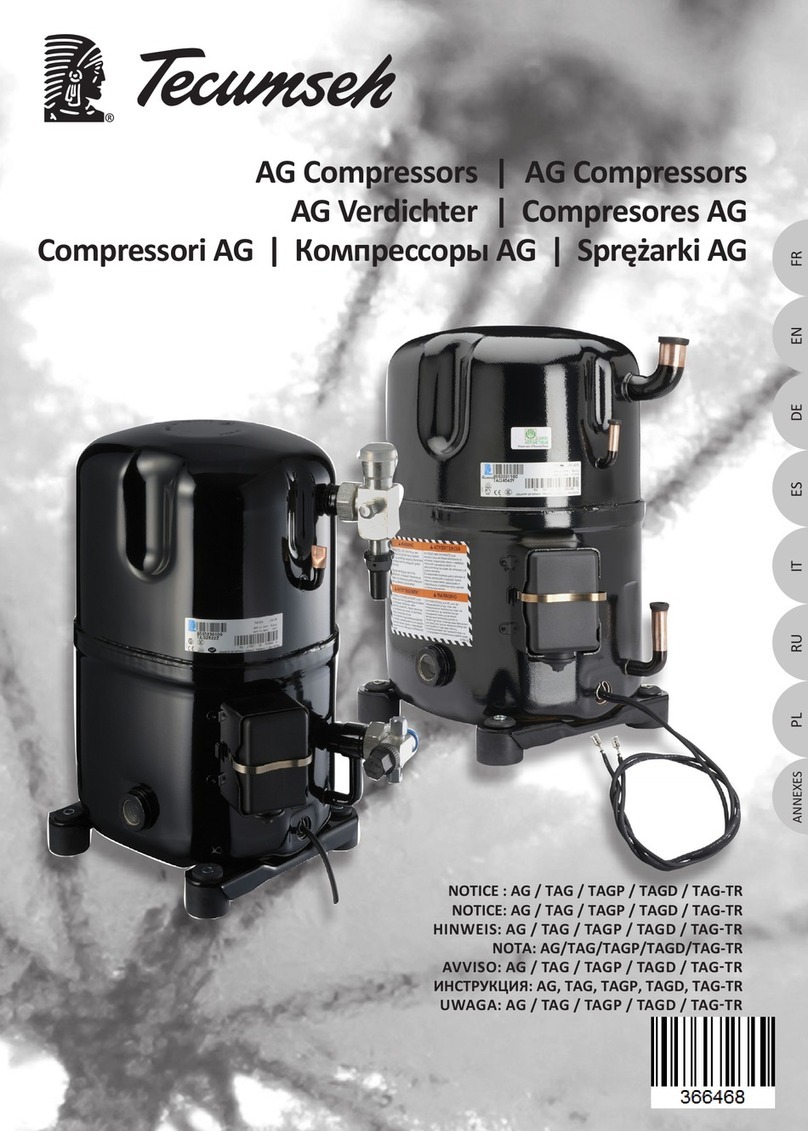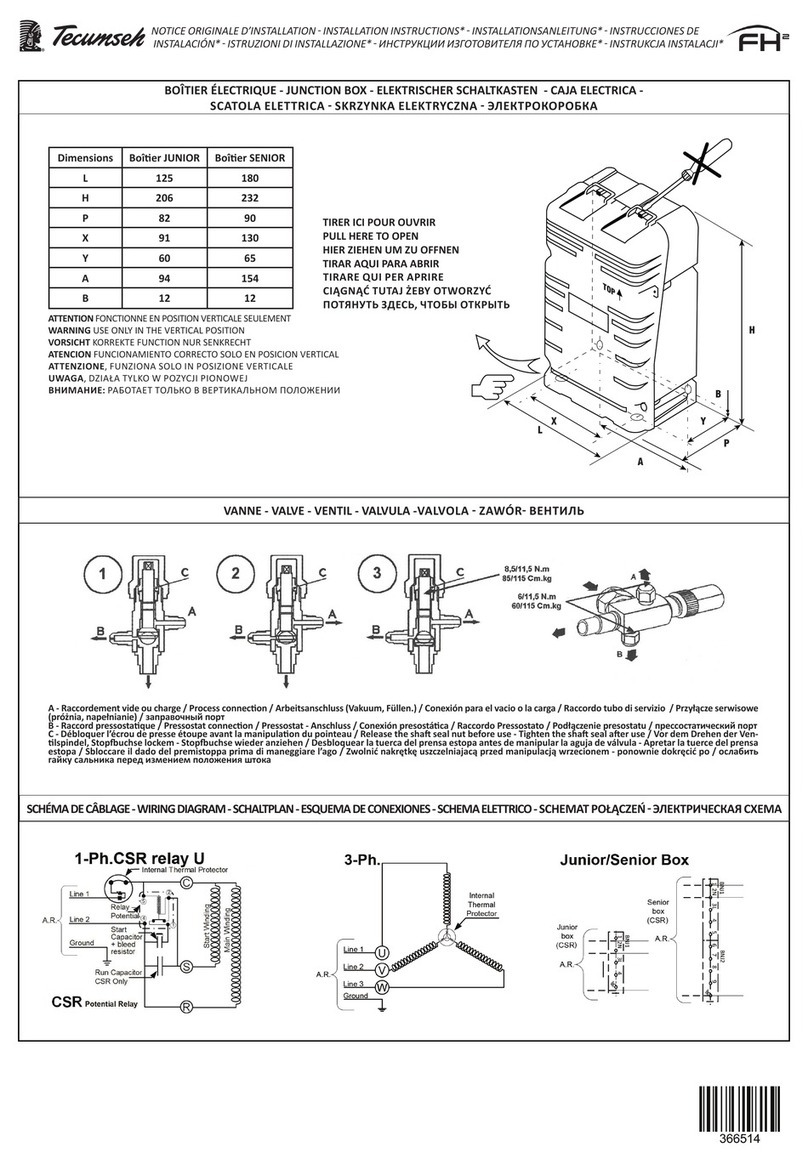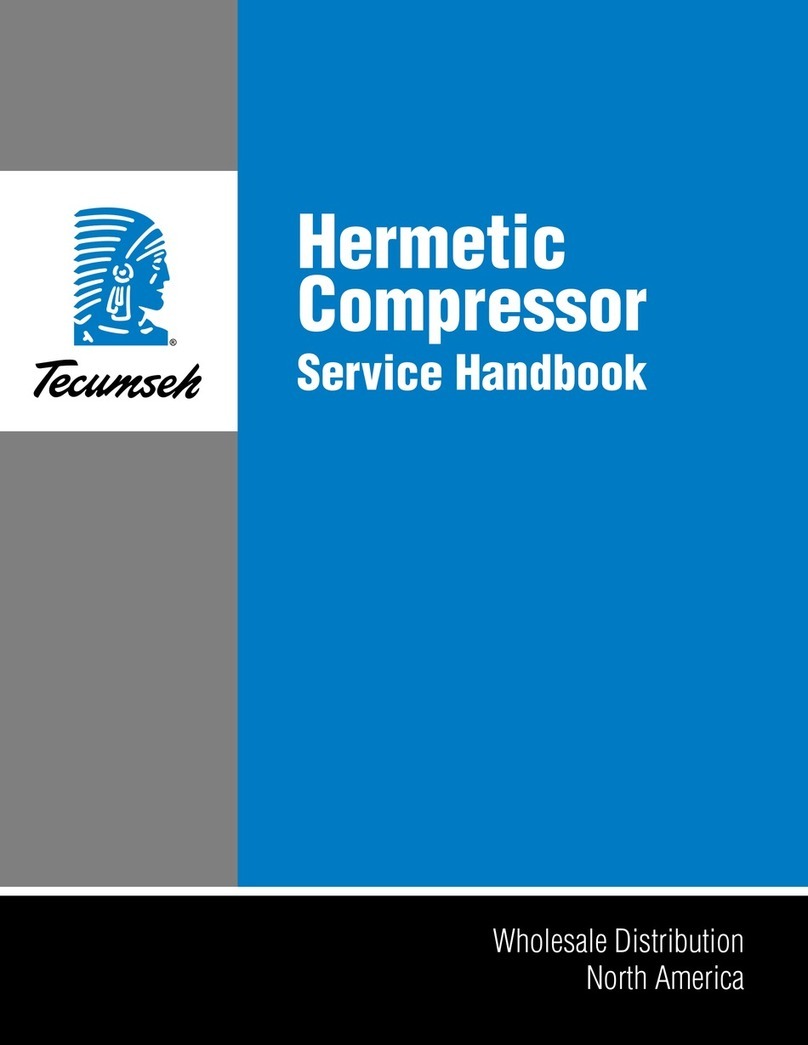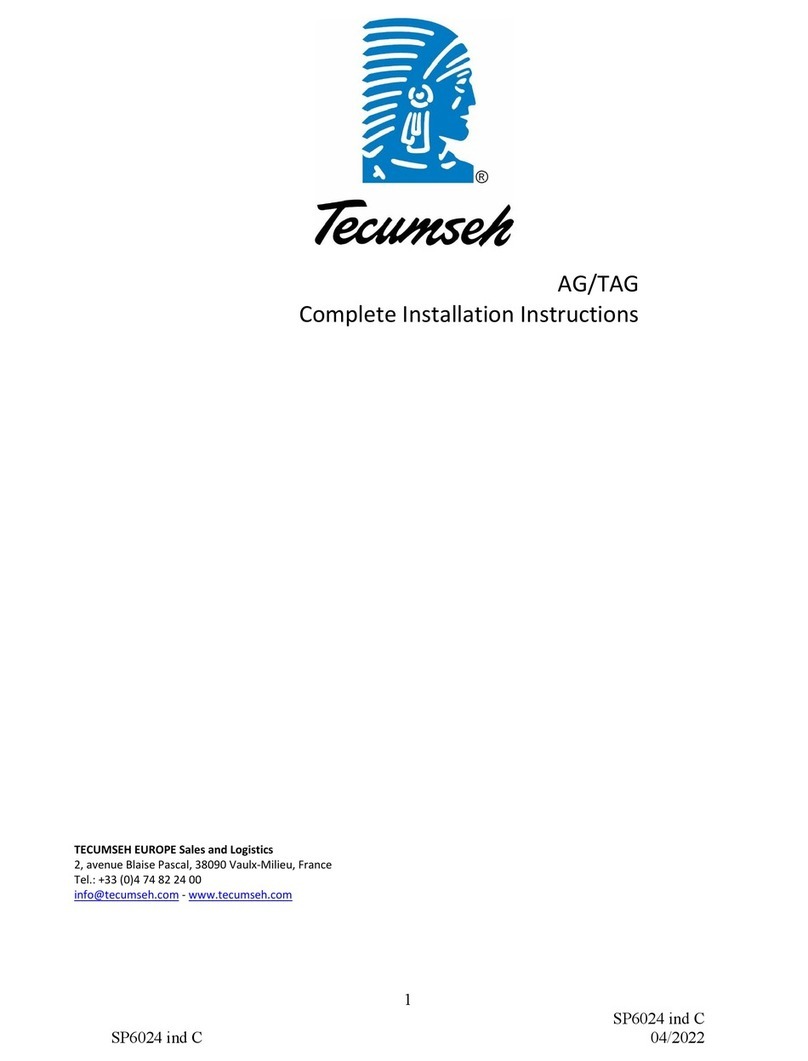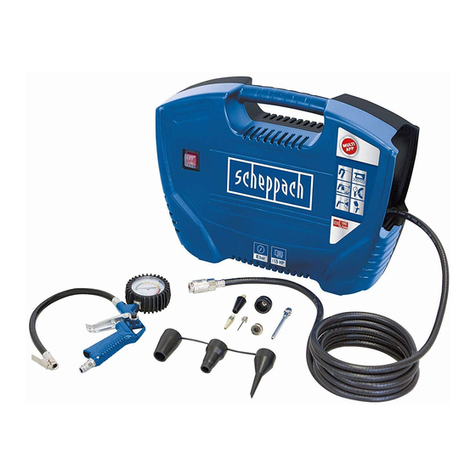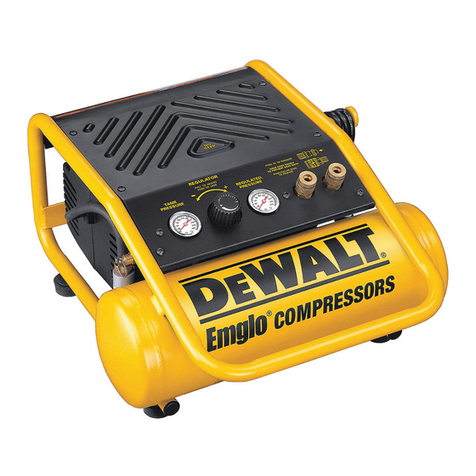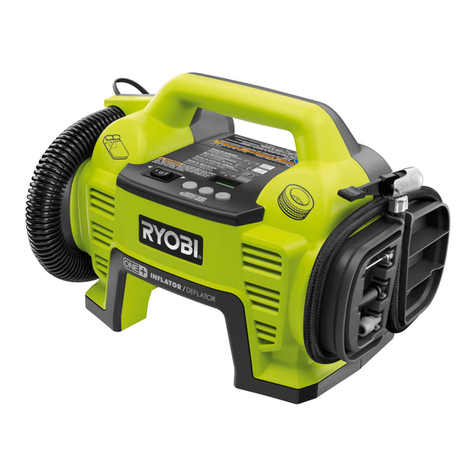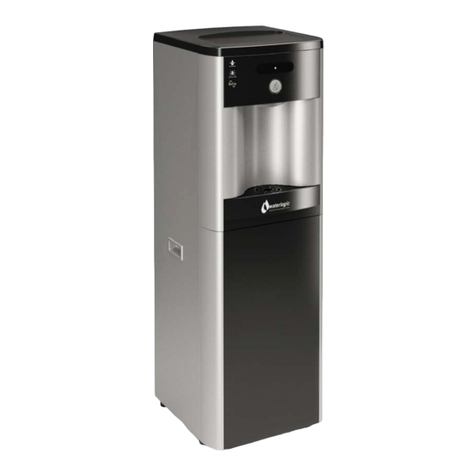Tecumseh VSC Series User manual

Terminal Pin Orientation
WIRING DIAGRAMS
3 PHASE
VSC Series Scroll Low (LBP) Compressor
for Commercial Refrigeration Installation Instructions
Part Number: 132-10011 Publication: TR-306 7/14
ELECTRICAL COMPONENTS
Use only new electrical components specific
for this compressor model.
NOTE: The compressor is delivered with a pressurized nitrogen charge (between 4 and
6 psig). Do not disassemble bolts, plugs, fittings, etc...unless all pressure has been
relieved from the compressor. Wear protective goggles and work gloves.
Under all circumstances, applicable local safety regulation requirements must be used.
The compressor must be handled with caution in the vertical position (maximum offset
from the vertical: 15°).
Never operate compressor without electrical terminal box cover in place and secured.
General Installation Instructions
These instructions pertain to the Tecumseh VSC Series Commercial (LBP) scroll
compressors used for refrigeration systems. They provide necessary information
regarding safety and proper usage of this product.
• Handle the compressor with care. Use the dedicated handles in the
packaging. Use the compressor lifting lug and use appropriate and safe
lifting equipment.
• Store and transport the compressor in an upright position.
• Store the compressor between -30°F and 158°F (-35°C and 70°C).
• Don’t expose the compressor and the packaging to rain or corrosive atmosphere.
• Never use the compressor in a flammable atmosphere.
• Mount the compressor on a horizontal flat surface with less than 7° slope.
• Verify that the power supply corresponds to the compressor motor characteristics.
• Use clean and dehydrated refrigeration-grade copper tubes and silver alloy brazing material.
• Use clean and dehydrated system components.
• The piping connected to the compressor must be flexible in 3 dimensions to dampen vibrations.
• The compressor must always be mounted with the rubber grommets supplied with the compressor.
• Slowly release the nitrogen holding charge through the discharge and suction ports.
• Connect the compressor to the system as soon as possible to avoid oil contamination from ambient moisture.
• Avoid material entering into the system while cutting tubes. Never drill holes where burrs cannot be removed.
• Do not exceed the maximum torque for rotolock connections (see below).
• Tightening torque of rotolock connections: 1'' = 59 ft-lb ± 15 1 1/4'' = 66 ft-lb ± 15 1 3/4'' = 81 ft-lb ± 15
• Connect the required safety and control devices. When the schrader port, if any, is used, remove the internal valve.
Important!
The VSC Scroll compressor must only be used for its
designed purpose(s) and within its scope of application
(refer to operating limits). Consult application guidelines
and datasheet(s) available at www.tecumseh.com
Suction Rotolock
Discharge Rotolock
WARNING
Never service, repair, or troubleshoot unless
you are qualified to perform these functions.
Improper servicing can lead to serious injury or
death from fire, electrical shock, or explosion.
Part Number: 132-10011 Publication: TR-306 7/14
HandlingSafety FirstAssembly
Ring connect screw terminals
C terminal box type
T1
T2
T3
push
push
push
Ring Connect Screw Terminal
T1
T2
T3
L1
L2
L3
Ring Connect Screw Terminal
T1
T3
T2
Vapor Injection Rotolock

Leak detection
• Never pressurize the refrigeration system with oxygen or dry air. This could cause fire or explosion.
• Do not use leak detection dye.
• Perform a leak detection test on the complete system.
• The low side test pressure must not exceed 450 psig.
• When a leak is discovered, repair the leak and repeat the leak detection.
Vacuum dehydration
• Never use the compressor to evacuate the system.
• Connect a vacuum pump to both the LP & HP sides.
• Pull down the system under a vacuum of 500 microns Hg.
• Do not use a megohmmeter nor apply power to the compressor while it is under vacuum as this may cause damage.
Electrical connections
• Switch off and isolate the main power supply.
• All electrical components must be selected as per local standards and compressor requirements.
• Refer to page 4 for electrical connections details. Three-phase applications, the terminals are labeled T1, T2, and T3.
• Tecumseh scroll compressors will only compress gas while rotating counter-clockwise (when viewed from the
compressor top). Three-phase motors will start and run in either direction, depending on the phase angles
of the supplied power. Care must be taken during installation to ensure that the compressor operates in the correct
direction.
• Use #10 - 32 screws and ¼” ring terminals for the power connection with ring connect screw terminal (C type).
Fasten with 26.6 in. lb torque.
• Use a self tapping screw to connect the compressor to ground.
Charging the system
• Keep the compressor switched off.
• Keep the refrigerant charge below the indicated charge limits if possible.
Above this limit; protect the compressor against liquid flood-back by using
a pump-down cycle or suction line accumulator.
• Never leave the filling refrigerant cylinder connected to the circuit.
Verification before commissioning
Use safety devices such as safety pressure switch and mechanical relief valve in compliance with both generally and
locally applicable regulations and safety standards. Ensure that they are operational and properly set.
• Check that the settings of high-pressure switches don’t exceed the maximum
service pressure of any system component.
• A low-pressure switch is recommended to avoid low pressure operation.
(Please refer to the Minimum Setting table to the right).
• Verify that all electrical connections are properly fastened and in compliance
with local regulations.
• When a crankcase heater is required, it must be energized at least 24 hours
before initial start-up and start-up after prolonged shutdown.
Startup
• Never start the compressor without the proper refrigerant charge.
• Do not provide electrical power to the compresor unless suction and discharge service valves are open, if installed.
• Energize the compressor. It must start promptly. If the compressor does not start, check wiring conformity and
voltage at the compressor terminals.
• Reverse rotation can be detected by following phenomena; excessive noise, no pressure differential
between suction and discharge, and line warming rather than immediate cooling. A service technician should be
present at initial start-up to verify that supply power is properly phased and that the compressor is rotating in the
correct direction. Phase monitors are required for all applilcations.
• If the internal overload protector trips out, it must cool down to 140°F (60°C) to reset. Depending on ambient
temperature, this may take up to several hours.
©2014 Tecumseh Products Company. All Rights Reserved.
Check with running compressor
• Check current draw and voltage. Measurement of amps and volts during running conditions must be taken at other
points in the power supply, not in the compressor electrical box.
• Check suction superheat to reduce risk of slugging.
• Observe the oil level in the sight glass (if provided) for about 60 minutes to ensure proper oil return to the compressor
• Respect the operating limits.
• Check all tubes for abnormal vibration. Movements in excess of 1/16 in (1.5 mm) require corrective measures such as
tube brackets.
• When needed, additional refrigerant in liquid phase may be added in the low-pressure side as far as possible from the
compressor. The compressor must be operating during this process.
• Do not overcharge the system.
• Never release refrigerant to the atmosphere.
• Before leaving the installation site, carry out a general installation inspection regarding cleanliness, noise and leak
detection.
• Record type and amount of refrigerant charge as well as operating conditions as a reference for future inspections.
Maintenance
Internal pressure and surface temperature are dangerous and may cause permanent injury. Maintenance operators and
installers require appropriate skills and tools. Tubing temperature may exceed 212°F (100°C) and can cause severe burns.
Ensure that periodic service inspections to ensure system reliability and as required by local regulations are performed.
To prevent system related compressor problems, following periodic maintenance is recommended:
• Verify that safety devices are operational and properly set.
• Ensure that the system is leak tight.
• Check the compressor current draw.
• Respect the operating limits.
• Confirm that the system is operating in a way consistent with previous maintenance records and ambient conditions.
• Check that all electrical connections are still adequately fastened.
• Keep the compressor clean and verify the absence of rust and oxidation on the compressor shell, tubes and electrical
connections.
• Acid / moisture content in system and oil should be checked regularly.
Warranty
Always provide the model number and serial number with any product warranty claim
The product warranty may be void in the following cases:
• Absence of compressor nameplate/label.
• External modifications; in particular, drilling, welding, broken feet and shock marks.
• Compressor opened or returned unsealed.
• Rust, water or leak detection dye inside the compressor. Do not overcharge the system.
• Use of a refrigerant or lubricant not approved by Tecumseh.
• Any deviation from recommended instructions pertaining to installation, application or maintenance.
• Use in mobile applications.
• Use in explosive atmospheric environment.
• No model number or serial number transmitted with the warranty claim.
Disposal
Tecumseh recommends that compressors and compressor oil should be recycled by a suitable company at its site.
QUESTIONS AND SUPPORT
Tecumseh reserves the right to change any information in this publication at any time.
This document is not intended to replace the training required for professional service personnel, or replace other information available from
refrigeration and air conditioning equipment manufacturers. The information in this document is intended to assist service personnel in safely
installing and servicing Tecumseh VSC Series Scroll compressors. Careful review of current application requirements is essential. IT IS THE
RESPONSIBILITY OF THE SERVICE PERSON TO ASSURE THEY HAVE PURCHASED A REPLACEMENT PRODUCT WHICH MEETS THE NEEDS
OF THE APPLICATION. Failure to do so may result in misapplication, requiring immediate or subsequent additional compressor replacement(s).
Minimum Settings
R22 7 psig
R134a 6 psig
R404A 20 psig
HP Refrigerant
charge limit (lb)
4 - 6 10
8 - 10 16
Table of contents
Other Tecumseh Air Compressor manuals
Popular Air Compressor manuals by other brands

North Star
North Star M459231B.1 Installation, operation and maintenance
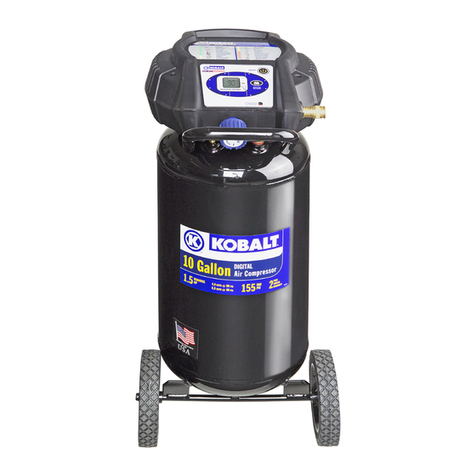
Kobalt
Kobalt 215914 parts manual

Trane
Trane RTRA Series Installation operation & maintenance

Streetwize
Streetwize SWPP1 Instructions for use
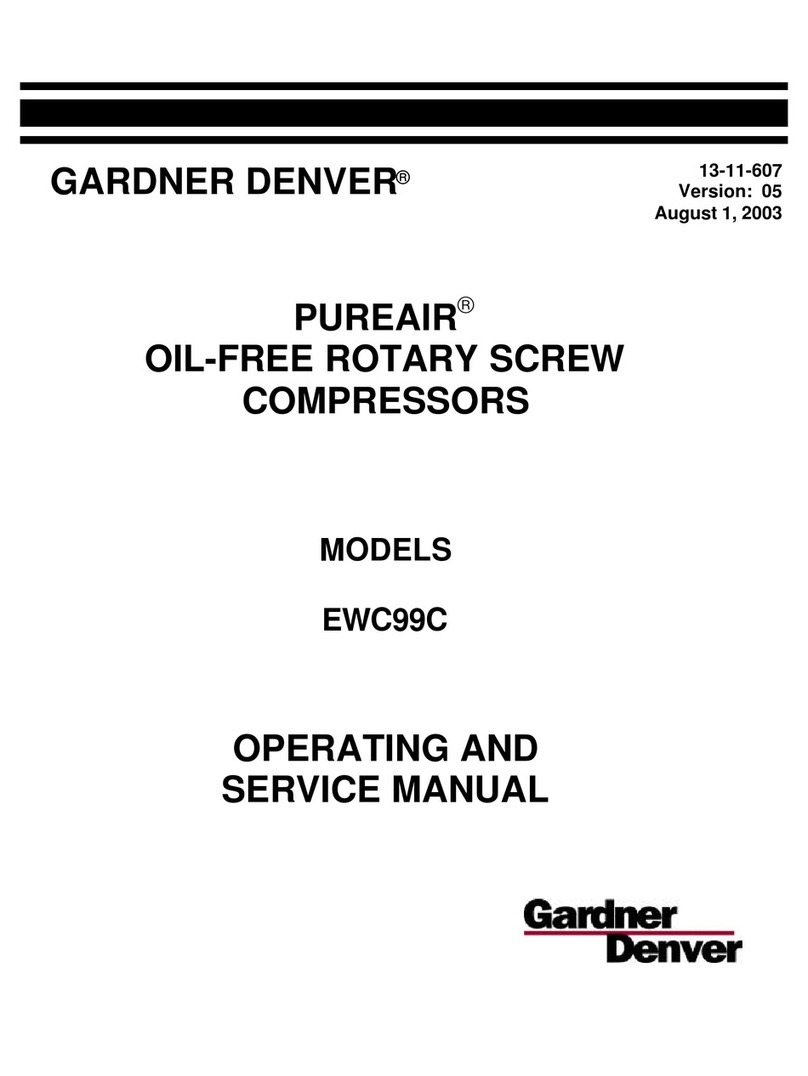
Gardner Denver
Gardner Denver PUREAIR EWC99C Operating and service manual

Gardner Denver
Gardner Denver ELECTRA-SCREW EDEQHH Operating and service manual
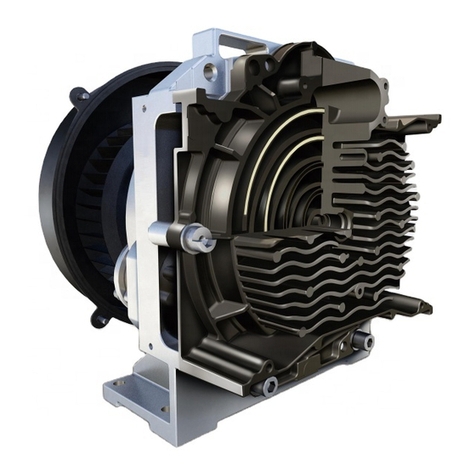
Powerex
Powerex SLAE03EB service and maintenance
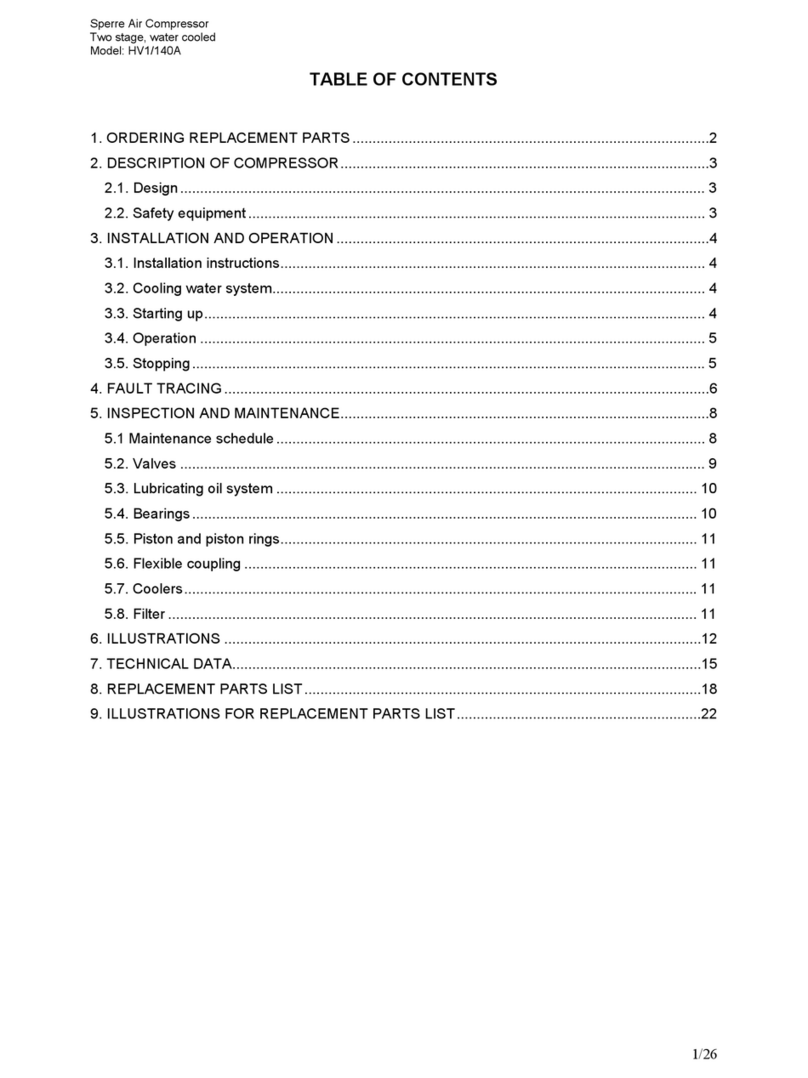
Sperre
Sperre HV1/140A Service manual
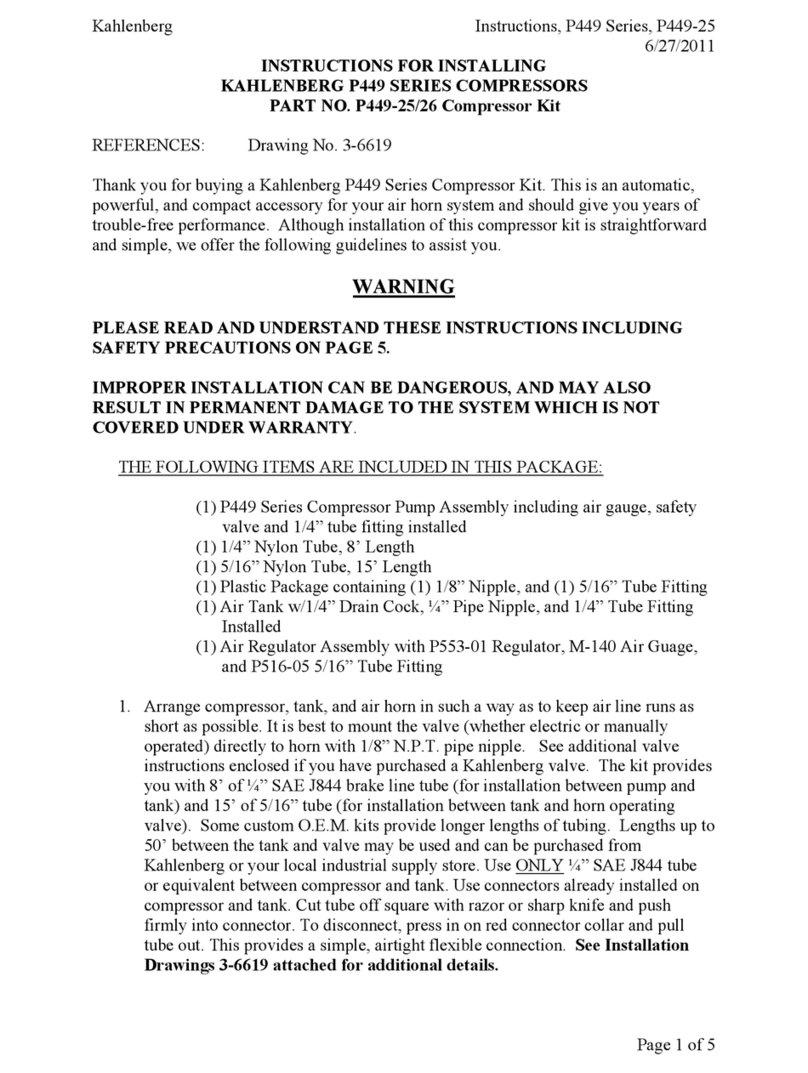
Kahlenberg
Kahlenberg P449 Series Instructions for installing
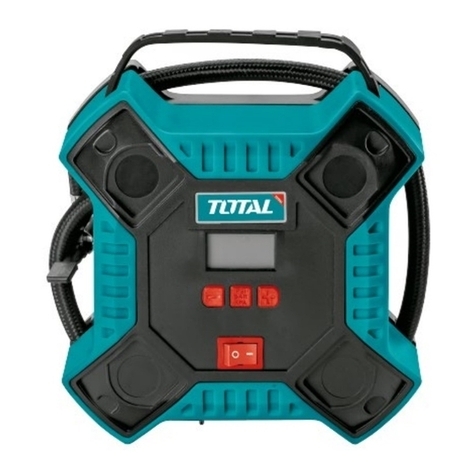
Total
Total TTAC1601 quick start guide

California Air Tools
California Air Tools 20040SPCAD owner's manual
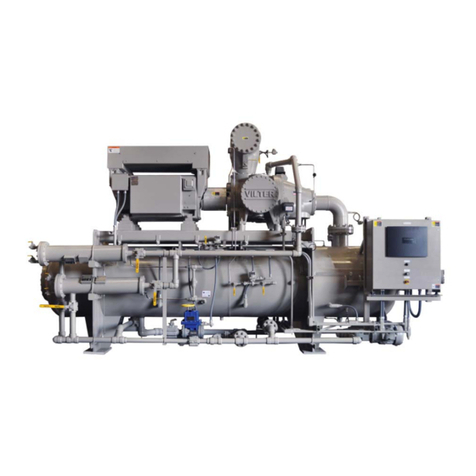
Emerson
Emerson Vilter VSG Installation, operation & maintenance manual
